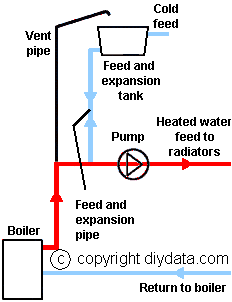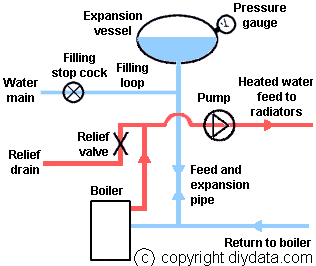Water Central Heating - the boiler
A water central heating system consists of basically the boiler, the radiators and the interconnecting piping.
The boiler heats the water and (normally) a pump circulates the water through the pipework and radiators and back to the boiler.
There are a number of different arrangements of boiler, pipework and supply to the radiators; each systems has its own advantages and drawbacks.
This page explains the boiler systems, refer to the related pages (see to the right) for other parts of the system.
The Boiler
The two main boiler arrangements are:
- Open vented systems
- Sealed systems
Open vented systems
 This basic design works well and is usually used where a hot water cylinder is used to store the domestic hot water. The system works at natural atmospheric pressure as the feed/expansion tank is open to the air.
This basic design works well and is usually used where a hot water cylinder is used to store the domestic hot water. The system works at natural atmospheric pressure as the feed/expansion tank is open to the air.
The feed/expansion tank is fitted high up above the rest of the system, often in the loft. The tank is fitted with a ball valve so that any water lost due to evaporation etc. is automatically replaced, the tank also allows for the water in the system to expand when it is heated, the ball valve need to be set very low so that the expanded water does not cause an overflow. The tank also allows for any water vented from the system up the vent pipe to be recovered, the vent pipe is connected from near the boiler and is bent over the tank. In older systems, the vent pipe was connected into the return pipe near to the boiler, however this does not meet current requirements which requires that both the vent and fill pipes to be adjacent to each other with no intermediate take offs.
From the tank, the water is fed down to connect into the system between the boiler and pump adjacent to the vent pipe.
Sealed System
 A sealed system normally operates at a pressure of about 1 Bar above atmospheric pressure, this pressure is achieved by a filling loop connected from the mains water supply to the system. A stop cock in the link allows for the system to be pressurised as required. Once pressurised, the system should retain its pressure unless the radiators are bleed or there is a leak in the system.
A sealed system normally operates at a pressure of about 1 Bar above atmospheric pressure, this pressure is achieved by a filling loop connected from the mains water supply to the system. A stop cock in the link allows for the system to be pressurised as required. Once pressurised, the system should retain its pressure unless the radiators are bleed or there is a leak in the system.
To avoid potential damage by excess pressure within the system (which normally will only occur if there is a fault in the system), a safety relief valve is incorporated so that any excess pressure is vented to atmosphere.
It is not generally practical to use an additive in sealed systems as there is no way for it to be added. In hard water areas various devices may be fitted in the feed to the filling loop to soften the water as it is added to the pressurised circuit. Such a softening device should reduce lime scale build-up in the system.
A lot of boilers are designed specifically for sealed systems and incorporate the boiler, controls, expansion vessel, pressure gauge & relief valve all within one casing. However all the various parts are available separately and it may be necessary to use separate components for large volume systems where the size of the expansion vessel needs to be relatively large.
It should be noted that not all boilers are suitable for connecting to sealed systems, the manufacturers technical details must always be consulted before using a boiler in a sealed system.
